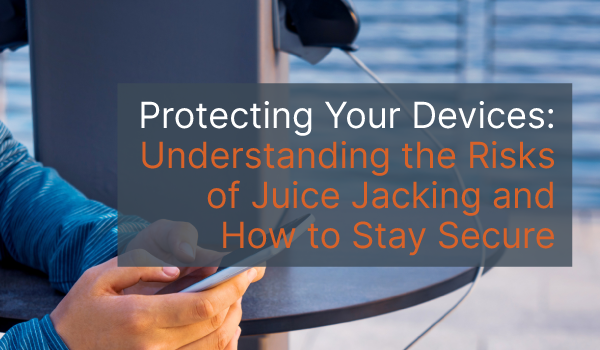When you’re out and about, there’s nothing worse than a dead phone battery when you need to stay connected – and nothing better than the sweet relief when encountering a public outlet.
Many public places offer free USB port charging stations, like airports, shopping malls, libraries, concert venues, hotel lobbies, and museums. They seem like an appealing solution to an uncharged device, but did you know they can put your data at risk?
You may have heard about the term “juice jacking”, a hot topic online since the FBI and FCC issued an advisory in April.
While this newer technology threat poses risks for individuals, business leaders must be extra cautious with employees who store confidential information on their work devices.
In this blog post, you’ll learn everything you need to know about juice jacking to stay prepared and avoid an attack.
What is Juice Jacking?
Juice jacking is a cyberattack method where hackers gain unauthorized access to your electronic devices plugged into a breached public charging station that has a compromised cable.
Juice jacking works similarly to the skimming devices that hackers used in gas pumps and ATM scams, adapting the technology to work with USB cables.
According to recent data, skimming credit card scams have escalated, with compromised cards increasing 368% from the previous year, believed by experts to stem from increased time spent on-the-go post-pandemic. Though increased juice jacking incidents didn’t inspire the recent FCC advisory, this method will likely follow a similar pattern.
How Does Juice Jacking Compromise Device Security?
Connecting your device to a previously-hacked USB charging station creates a direct gateway for criminals to access your personal data – including your financial assets.
A device’s USB port provides users with two functions: it supplies electrical power, aka “juice,” and enables data transfer.
While you think you’re charging your phone, a cybercriminal will infiltrate your system to steal data, lock you out of your device, or install malicious software. Often, people won’t know that someone stole their data, so they keep spreading the malware when they connect their compromised devices to other machines.
Once they have your data, they can use it for various nefarious purposes. Read our recent blog post, “What Do Hackers Do With Stolen Data?” to learn more.
Secure Charging Alternatives and Tools
In an ideal world, your best alternative for secure charging would be charging your device at home, in your car, at work, or another private destination. Depending on your vehicle, you can use USB cables and other adapters to give your devices much-needed fuel.
You can also keep external batteries or a power bank in your bag for a low-battery emergency. There’s even a tool called a USB condom, also known as a data blocker, which prevents data extraction from your device.
However, if you’re in a bind in public and have no tools, using a wall outlet is much less risky than an untrusted USB cable.
Best Practices for Device Security
Beyond juice jacking, device security has dominated our newsfeeds recently, with stories like Prince Harry’s phone hacking court case or the Mackenzie Investments data breach.
In recent years, we’ve filled our homes and offices with internet-connected devices, from our laptops and televisions to our voice-activated assistants and fitness trackers.
Among people with twenty or more devices at home, 24% have experienced two or more cybersecurity incidents in the past year, according to recent Deloitte research.
With the threat of a cybersecurity incident constantly looming, prioritizing your overall device security is critical. You can keep navigating your digital life worry-free when you adopt standard device best practices, such as:
- Developing safer browsing habits
- Backing up your data regularly
- Embracing technological innovations like encryption and VPNs.
If you want to strengthen your mobile security, read our recent article: 6 Tips on How to Protect Your Phone From Hackers.
Safeguarding Your Company and Sensitive Data: PC Corp’s Comprehensive Security Solutions
You want your team to keep focusing on their tasks with the peace of mind that they won’t encounter massive disruptions to their productivity.
As part of our Managed I.T. Services at PC Corp, our cybersecurity experts will equip you with the most effective tools and strategies to avoid a cyber attack’s negative ramifications. After collaborating with you to develop a customized security plan, you can protect your data and customer trust.
Connect with us today to strengthen your I.T. infrastructure.
